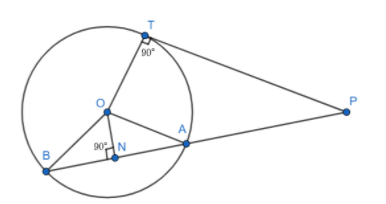Question
Question: From an external point P, a tangent PT and a line segment PAB are drawn to a circle with centre O. P...
From an external point P, a tangent PT and a line segment PAB are drawn to a circle with centre O. Prove that PA.PB=(PT)2
Solution
To solve the question, we have to draw a perpendicular from the centre of the circle to line segment AB to get equations of PA, PB. To solve further, apply right-angle triangle symmetry rule which states two right-angle triangles are congruent when hypotenuse is equal along with common angle. To calculate the answer, apply Pythagorean theorem to ease the procedure of solving.
Complete step-by-step answer :

Draw a perpendicular to AB from the centre of triangle O to a point N.
Thus, ON is perpendicular to AB.
From the above diagram we get,
PN = PA + AN
Thus, the length of PA can also be written as PN - AN.
PA = PN – AN …. (1)
From the above diagram we get,
PB = PN + BN …. (2)
Thus, the length of PB can also be written as PN + BN.
By multiplying of equations (1) and (2), we get
PA. PB = (PN – AN). (PN + BN) ……(3)
Consider ΔONA and ΔONB
We know OA = OB since OA and OB are equal to radius of the circle.
We know ∠ONA=∠ONB since the value of ∠ONA,∠ONB is equal to 900 since ON is perpendicular to AB.
Thus, ΔONA and ΔONB are congruent by hypotenuse and right-angle symmetry of the right-angle triangle.
We know that in congruent triangles their corresponding sides are equal.
Thus, we get,
AN = BN
By substituting the above value in equation (3), we get
PA. PB = (PN – AN). (PN + AN)
PA. PB = PN2−AN2 ….. (4)
Since we know the formula (a+b)(a−b)= a2−b2
We know that by Pythagorean theorem, we get, in a right-angle triangle XYZ XZ2= XY2+YZ2 where XZ is hypotenuse and XY, YZ are two adjacent sides of the given right-angle triangle.
By applying the above theorem for ΔONP and ΔONA , both right angled at N, we get we get
OP2= ON2+PN2
OA2= ON2+AN2
By subtracting the above two equations, we get
OP2−OA2= PN2−AN2
PN2−AN2=OP2−OA2 …… (5)
We know OA = OB = OT since OA, OB, OT are equal to radius of the circle.
By substituting the above value in the equation (5), we get
PN2−AN2=OP2−OT2
By applying Pythagorean theorem for ΔPOT, right-angled at T, we get
OP2=PT2+OT2
PT2=OP2−OT2
Thus, by substituting equation (5) in the above equation, we get
PN2−AN2=PT2
Thus, by substituting equation (4) in the above equation, we get
PA.PB=(PT)2
Thus, we get PA.PB=(PT)2
Hence, proved.
Note :The possibility of mistake can be not drawing perpendicular from the centre of the circle to AB, which eases the procedure of solving. The other possibility of mistake can be not applying triangle symmetry rule and Pythagorean theorem to do further calculation.
